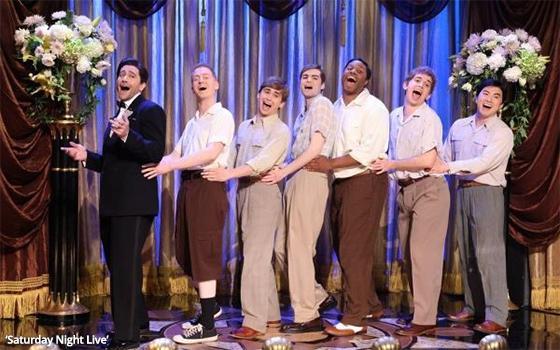
I once had an editor -- a very good one -- who
prohibited anniversary stories.
Anniversaries and similar milestones are not news, he would say. They are opportunities for publicity ginned up by network publicity
departments.
In essence, it was manufactured news -- manufactured by them, not us.
I took this to heart for years after, but made very occasional
exceptions such as this TV Blog about the 50th season of “Saturday Night Live” that begins this weekend.
If this milestone is not exactly
news (since everybody has known it at least since last spring, if not before), it is worth mentioning because of the sheer novelty of it.
Fifty years on TV
is a rare thing, limited mostly to the network evening newscasts and Sunday public affairs shows, and some daytime soaps.
advertisement
advertisement
NBC has achieved it on Saturday
nights and weeknights. “The Tonight Show” dates back to 1954. In the morning, NBC’s “Today Show” is even older. It has been on since 1952.
Personally, my own days of watching “Saturday Night Live” ended years ago. As the years went by, “SNL” just wasn’t for me anymore, which might be the key to
the show’s longevity.
“SNL” has had a knack for pivoting at just the right time to capture the attention of succeeding generations.
The show is starting its 50th season on Saturday, but it is 49 years old. Its first season premiered on October 11, 1975. The show is
old, but to my knowledge, it still skews young and always has.
When I think back on its history, I visualize it in terms of its various casts. If memory serves, the
show never jettisoned entire casts all at once, but the show’s history is divided into distinct eras anyway.
There was the Chevy Chase, Gilda Radner, Dan Aykroyd, Bill
Murray era; the Eddie Murphy era; the Mike Myers, Dana Carvey era; the Will Ferrell era; the Kristin Wiig era; and the rest.
The “eras” all overlapped, of course, but there was still something distinctive about all of them. The upshot is that “SNL” has always drawn new audiences to
replenish the old.
One person transcends all the social changes, cast changes and all the eras of “SNL” -- Lorne Michaels, 79.
Having never personally observed the man working, I have no idea what it takes to do what he did, which is to
sustain a show with so many moving parts for so long.
Among other things, Lorne Michaels made stars. Sometimes I contemplate the question: Who is the biggest
star to come out of “Saturday Night Live”?
There are quite a few candidates: Chevy Chase, Dan Aykroyd, Bill Murray, Eddie Murphy, Mike Myers, Adam Sandler, Will
Ferrell, Tina Fey and so many others.
Who have I missed? Probably a lot of them, but that is to be expected.
Wikipedia lists 167 cast members over the show’s five decades. Who can remember them all?
With so many celebrated alumni now working in all manner of
comedy content, it can be said with a high degree of accuracy that “SNL’s” influence on comedy since its very beginning is immeasurable.
It
was a turning point in TV. Sketch comedy had long been a staple of network TV on the many variety shows of the 1960s and into the ’70s.
But unlike the
comedy on the variety shows, the sketch comedy of “SNL” was rebellious and somehow important to an audience made up primarily of post-counterculture college kids.
When “SNL” came along, the old ways were dead. The miracle is that now “SNL” itself is old, but still
relevant. The show has lessons in reinvention that all of us might learn from.
Above photo from “Saturday Night Live,” May 2024.
Courtesy of NBC.